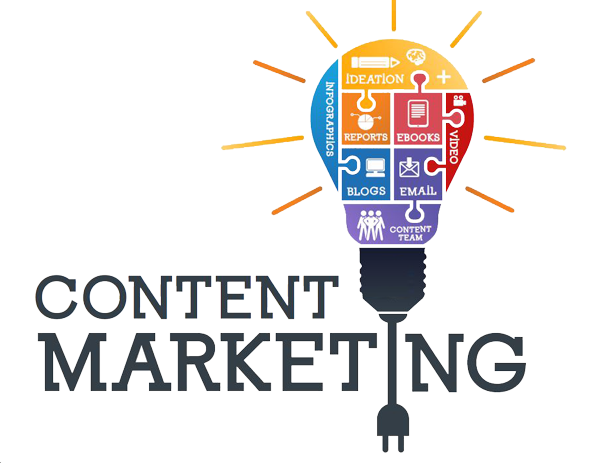What is Content Marketing? Everything you need to known about Content Marketing

Content marketing is a type of marketing where content is created and distributed online to attract attention and drive traffic to websites. There are many different types of content, including text-based articles, images, videos, podcasts, infographics, blogs, webinars, social media posts, etc.
The term “content” refers to anything that provides value to consumers. Consumers want to know about products and services they use. If you provide them with useful information, they will share it with their friends and family. This helps build trust and brand awareness.
Content marketing is a great way to get your business noticed. You can create valuable content that educates your audience and attracts potential customers. When people find out about your business, they will want to learn more about what you have to offer.
Here are some examples of content marketing:
- Blogging – Create blog posts about topics related to your industry. Posting regularly keeps readers interested and coming back for more.
- Infographics – Use visual content to explain complex ideas. These graphics are often shared on social media sites.
- Videos – Make short videos that educate your audience. People love watching videos!
- Social Media Posts – Share interesting facts, news stories, and updates on your company.
- Webinars – Host live events on YouTube or Facebook Live. Your viewers can ask questions and interact with you directly.
If you need help getting started with content marketing, contact us today!

What Is a Content Marketing Strategy
A content marketing strategy is a plan of action to create and distribute high-quality content to attract customers and prospects online. It should focus on building trust and relationships with potential customers rather than just selling products. It helps businesses increase their visibility and credibility while attracting new customers. Content marketing strategy can be used by any business regardless of industry.
A good content marketing strategy should have these components:
- Creating great content
- Developing a content calendar
- Optimizing content for search engines
- Measurement the result
- Reporting the data/result that we have achieved
- Review the data and optimizing your content marketing strategy according.
Why Do You Need a Content Marketing Strategy
A content marketing strategy is not just about writing articles and posting them online. There’s much more to it than that. In order to make sure that you’re getting the best results out of your efforts, you need to take time to plan your campaign properly. Here are some reasons why you need a content marketing strategy:
- Attract potential customers
- Educate current customers
- Build brand awareness
- Increase sales
- Improve SEO rankings
- Generate leads
- Boost social media engagement
The 5 Elements my content marketing strategy include
1. Audience
Who is your audience? What do they care about? Who are their influencers? How much time do they spend online? What type of content does your brand produce? These questions help you understand who you’re trying to reach and what kind of content resonates best with them.
2. Message
What is your message? Is it clear, concise, and compelling? Does it align with your brand values? Can you express yourself clearly in writing? A powerful message should always be based on truth, not just something that sounds good.
3. Call-to-Action (CTA)
How can someone take action after reading your content? Do you have any links to additional pages where people can learn more? Are there any forms that need to be filled out? Make sure your CTA is clear and simple.
4. Visuals
Visuals are an important part of any content marketing strategy. Images and videos tell stories and convey messages more effectively than words alone. Use visuals strategically throughout your content.
5. Measurement & Optimization
Measure everything! You don’t want to miss opportunities to improve your content marketing efforts. Track how many views each piece of content gets, how long users stay on your site, and how often they share your content. Look at analytics data regularly to identify patterns and make improvements.
Four types of content ideas work best and that help building a successful content marketing strategy:
- Informational content
- How-to content
- Case studies
- Reviews

How often should I update my content marketing strategy?
1. Every month
Content marketing is not something that happens once and then done. Content marketing is a continuous effort that requires constant attention and maintenance. You need to keep your audience engaged and interested in what you have to say. If you don’t do this, they will eventually lose interest and move on to the next thing.
2. Once a week
If you want to create great content, you need to put some time into it. You need to take the time to research and write about topics that matter to your target audience. If you don’t, you won’t get any traction.
3. Twice a week
You should try to post at least twice a week. This gives you the opportunity to share information that matters to your audience. It also gives them a chance to read your content before anyone else does.
4. Daily
Daily posting is the best way to ensure that you reach your audience. Your audience wants to know what’s going on in your industry. Posting daily keeps them informed and helps build trust between you and your audience.
5. Weekly
Weekly posts give you the opportunity to talk about things that happened over the past week. This also lets your audience know what’s going on around them and how their lives may be affected by these events.
6. Monthly
Monthly posts let you talk about things that happened in the last month. This lets your audience understand what’s happening now and what’s coming up soon.
7. Quarterly
Quarterly posts let you talk to your audience about things that happen in the last three months. This lets them know what’s going on right now and what’s coming down the road.
7 Steps to Create a Content Marketing Strategy to Grow Your Business
1. Define your business goals
This step should be done before any content marketing strategy is created. You need to know what you want out of your content marketing efforts. Do you want to increase website traffic? Increase conversions? Generate leads? What do you want to accomplish? Once you have defined your business goals, then you can start thinking about how you can achieve them.
2. Identify your audience
Who is your target audience? Who are they? Where do they spend their time online? How much time do they spend on social media platforms? These questions help you identify who your ideal customer is. Knowing who your customers are helps you create content that’s relevant to them. If you don’t know who your customers are, you may end up writing content that doesn’t resonate with them.
3. Determine your content creation schedule
How often will you produce content? Will you write blog posts weekly, monthly, or quarterly? Will you create videos or infographics? Determine your content creation frequency based on your business goals.
4. Develop a content calendar
Once you know your content creation schedule, you can begin developing a content calendar. A content calendar outlines the types of content you plan to create, when you plan to publish each piece, and where you plan to distribute your content.
5. Choose your distribution channels
Now that you have determined your content creation schedule, it’s time to choose your distribution channels. Which social media platform(s) will you use to share your content? What email list provider will you use to send your content? Which blogging platform will you use to post your content? Choosing the right distribution channel for your content is critical to its success.
6. Plan your content promotion
After you determine your content creation schedule and distribution channels, it’s now time to plan your content promotion. What type of content will you promote? Blog posts? Infographics? Videos? Podcasts? Each type of content requires different methods of promotion.
7. Measure your results
Finally, it’s important to measure your content marketing results. How many people did you reach? Did you generate leads? Did you increase sales? Did you get more website traffic? By measuring your content marketing results, you can determine whether your content marketing efforts were successful.

SEO vs content marketing vs Social media
1. SEO
Search engine optimization (SEO) is the practice of increasing the visibility of a website or webpage in a search engine’s unpaid results like Google, Bing, Yahoo etc. Which is often referred to as natural, algorithmic, or organic rankings. Search Engine Optimization includes both on-page and off-page activities. On-page activities may include things like using keywords in title tags, meta description, heading tags, etc., while off-page activities may include backlinks, social media sharing, etc.
2. Content Marketing
Content marketing is a type of marketing where companies create free valuable information and publish relevant, consistent, and engaging information to attract their target audience. Beside it involves creating and distributing content to achieve business goals through the use of various communication channels like via social networks, blogs, email lists, etc.
3. Social Media Marketing
Social media marketing is a method of promoting brands through social networking websites like Facebook, Twitter, Instagram, Pinterest, YouTube, LinkedIn, etc. These platforms provide businesses with an interactive forum for reaching current and potential customers. Most social network sites have their own messaging system known as a newsfeed, which displays the latest stories, messages, and advertisements posted by users. Through social networks, individuals share ideas, opinions, events, culture, and purchase experiences, therefore strengthening the relationship between businesses and consumers.






